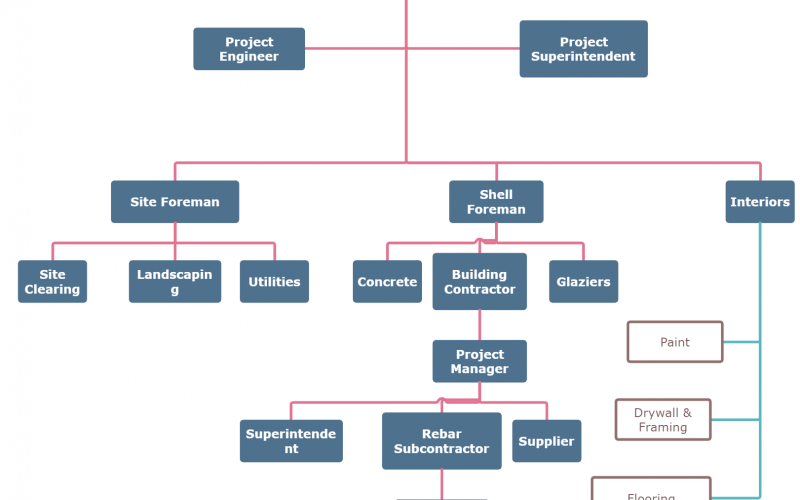In the majority of firms, it’s crucial to create a hierarchy that clarifies everyone’s position within the team. Each role has a specific amount of accountability, and managers can set up routines to keep the company operating efficiently. Once a corporation has grown sufficiently to require the graphical depiction that an organization chart provides, company owners or executives typically produce an organization chart. In this post, we describe organizational charts, talk about, Tech., construction, and manufacturing company organizational Chart., and also give some examples.
Company Organizational Chart
- An organizational chart is a visual representation of a company’s internal structure that lists each employee’s relationships, jobs, and responsibilities. This is one way of picturing a bureaucracy.
- Other names for organizational charts include “org charts” and “organization charts.”
- An organizational chart outlines the various positions, teams, and duties that link the staff members of the business to one another and to the management group.
- Organizational charts can be comprehensive and show every aspect of the business, or they can be department- or unit-specific and concentrate on a single component of the wheel.
- The majority of organizational charts have a “hierarchical” structure, with senior management or other officials at the top and lower-level personnel below them.
The divisional org chart, the matrix chart, and the flat org chart are examples of other sorts of charts.
Uses of Company Organisation charts
It is easy to see the relationships inside an organization using org charts, and you can also learn how to transmit critical information successfully. Using org charts is beneficial in
- Ensuring that staff members are aware of who to report to or encouraging internal networking are examples of communication between companies and managers. Using staff images can greatly help in connecting names and faces.
- Modifying team members’ tasks to best utilize everyone’s abilities when rearranging.
- Making choices regarding the specifics of a new employment program may be part of organizing the workforce.
- The shifting of occupations to decrease inefficiencies is one instance of resource planning.
- In essence, a family tree is a form of organizational chart in genealogy. You can include pictures, the birth and death dates of each person, and connections to more resources.
Types of organizational structures
The following are types of organizational structures
#1. The divisional or multidivisional structure
In the actual world, typical organizational systems come in four fundamental varieties. A functional structure is the first and most common form. It separates a business according to how much employee specialty there is, and is occasionally referred to as a bureaucratic organizational structure. The vast majority of small to medium-sized firms employ a practical structure. The company is organized bureaucratically and has departments for operations, sales, and marketing.
#2. Flat Structure
A flat structure, often referred to as a horizontal structure, is more popular today and preferred by business owners. It flattens the hierarchy and provides employees with a great deal of freedom, as the name would imply. Business organizations quickly adopted this structure.
#3. Functional Structure
The majority of small and medium-sized enterprises adopt a practical organizational structure that separates a company by personnel expertise. The company is bureaucratic, with sales, marketing, and operations divisions.
#4. Team-Based
Similar to divisional or functional structures, team-based businesses organize their workforce into close-knit groups of workers to carry out specified duties, but each group comprises both leaders and workers.
#5. Network Structure
Supplier and contractor networks help complete essential tasks. It has a small main office, and a few scattered satellite offices, and it outsources some of its most important duties to consultants and other companies.
#6. Circular Structure
The name “circular” comes from the fact that higher-level workers and supervisors are positioned at the center, with concentric rings stretching outward to accommodate lower-level workers. The many strata of the organization are encouraged to work together and communicate openly through this organizational structure.
#7. Matrix Structure.
Matrix companies are also possible. Additionally, it is the least clear-cut and perplexing. Under this plan, workers move between different departments, divisions, and bosses. An employee in a matrixed organization might be in charge of both sales and customer support, for example.
Company Organizational Chart Example
To make it easy for you to choose the org chart examples you prefer, we’ve listed them all. The company’s organizational chart’s best real-world examples are provided in this section. You can use the suggestions below as inspiration.
#1. Microsoft Organizational Chart
Microsoft’s organizational structure uses both functional and divisional structures. The same information is displayed in the organizational chart for Microsoft that is posted here. Despite the fact that it would seem more plausible, these departments actually operate out of multiple sites. You can use this chart as a model to create your own if your company faces a problem similar to this one. Microsoft has departments such as:
- Human Resources
- commercial and legal affairs
- Engineering
- Dynamics
- Advanced Research and Strategy
- Finance
#2. Manufacturing Company Organizational Chart
Anything can be produced, but there is always a company that does this. The organizational structure of a manufacturing company depicted above shows how outside services, both public and private, may cooperate with the enterprise. a manufacturing company’s organizational hierarchy, for example. The ISO department, a regulatory body here in the manufacturing organization, also works to make sure that all activities are carried out in line with the established standards. Divisional and matrix models can also be used to build the structure because a manufacturing firm may have some departments spread out globally.
#3. Apple Organizational Chart
The Apple organizational structure is best exemplified by this. The image, which displays the important figures in the business, was made using the hierarchy organizational chart paradigm. The organizational structure has Apple CEO Tim Cook at the top, and each department begins to flow from the COO. Despite the size of Apple, this image only provides a vague glimpse of the entire firm. Now that you have these charts, consider how easy decision-making is.
#4. Google Organizational Chart
A functional organizational chart manages business units when departments collaborate across functional boundaries.. The Google organizational chart resembles a functional organizational chart more and demonstrates how the company’s departments work together across functional boundaries to ensure its survival. If your company practices cross-functional collaboration, you can apply some of these organizational chart concepts. The graph pinned above is also only marginally flat. This graph was created when Google was just getting started
#5. Mcdonald’s Organizational Chart
On this page, the McDonald’s organizational chart is visible. The corporate organizational chart can be created from all four organizational charts due to Macdonald’s multinational operations and the typical cross-functional nature of a corporation like this. These concepts could serve as a source of inspiration for further study. The most unique aspect of the system is that, in the high-level overview, every vice president of different divisions reports to the same president or Chief Operating Officer (CEO).
#6. Construction Company Organizational Chart
It serves as the building company’s organizational framework. The picture uses a hierarchical organizational chart method because construction businesses don’t have divisions scattered across several sites. A matrix or functional structure can also be used to develop a construction company organizational chart because different departments in the construction sector work across functional boundaries. Based on the guidelines in this chart, you can make your own chart to manage them. The construction company organizational chart shows department managers working together without corporate leadership.
Tech Company Organizational Chart
In the very competitive global market, technology enterprises frequently have their own distinctive core competitiveness. Technical businesses can also be classified into other categories, per the industry, including electronic information, new energy, new materials, biotechnology, mobile applications, and many others. These categories of tech company have the potential to have distinctive organizational chart.
#1. Biopharmaceutical Tech Company Organizational Chart
One of the most crucial fields at the leading edge of science for a very long time has been biopharmaceuticals. To meet consumer demand, biopharmaceutical companies may improve their internal organizational structures and allot more resources.
#2. New Energy Tech Company Organizational Chart
Clean energy appears to be a topic of great interest in the near future because of the serious environmental damage. New energy companies with specific product advantages can employ a range of dividends to build a strong brand. Such new energy businesses can grow continually by synchronizing the organizational structure and optimizing personnel placement.
#3. New Material Tech Company Organizational Chart
The addition of new materials is necessary for the rejuvenation of scientific and technological goods at every level. Organizational structures and floor plans for these businesses are considerably diverse from those of e-commerce or software firms.
Construction Company Organizational Chart
The functions and organizational structure of a construction company are visually represented in an organizational chart. An org chart makes it straightforward for stakeholders and employees to grasp how operations are related to one another, which improves their comprehension of how the business functions. Construction companies have several fundamental functions:
- The human resources department
- Purchasing Department
- Engineering department
- Financial departments
- Marketing departments
The following is each department’s duties and responsibilities
#1. Financial Department
The financial department is responsible for managing the company’s cash flow and making sure there are enough resources on hand to meet daily responsibilities.
#2. Human Resources Department
The HR department is in charge of hiring and training staff, keeping records, paying salaries and benefits, providing insurance, and managing employee relations.
#3. Purchasing Department
The primary responsibility of the purchasing department is to acquire the materials and supplies required for ongoing projects and activities. They must compare products from many sources in order to select those with the best features and costs.
#4. Engineering Department
The engineering department often takes care of the planning for the construction project. This includes planning the building process, preparing surveys, gathering data, and analyzing the results, as well as providing technical support as required during the project.
#5. Marketing Department
The marketing division is in charge of performing market research, coming up with marketing plans, and managing the development of new products and sales, advertising, pricing, and promotions.
#6. Project Department
The project departments plan and manage all projects. Project managers set budgets, assign tasks, and monitor worker safety. They must complete the contract-compliant building project.
Manufacturing Company Organizational Chart
An organizational framework called a manufacturing company organizational chart describes the hierarchy of duties and responsibilities inside a business or factory. Depending on the size, breadth, and nature of the company’s products, the structure will change. However, a company manufacturing organizational chart frequently shares a few components. These components might consist of:
- Executive group: The CEO, CFO, and other senior executives are responsible for setting the company’s direction and strategy.
- Plant managers These people are in charge of overseeing the daily operations of the manufacturing facility.
- Production employees: These workers actually put things together and make them.
- Quality control: This division ensures that the goods adhere to the necessary requirements.
- Receiving and shipping: The logistics division is in charge of the logistical planning for product shipping and delivery.
Types of Manufacturing Organizational Chart
Manufacturing company organizational chart often fall into one of three categories: functional, divisional, or matrix. Let’s examine each one in more detail.
#1. Functional Structure
Employees are organized into functional manufacturing organizational groups based on their areas of specialization. One department might house all the engineers, while another might house the production staff.
#2. Divisional Structure
A divisional industrial organizational structure separates workers by product line or market. For instance, all of the personnel responsible for producing automobile parts would fall under one division, whereas all of the personnel responsible for making
#3. Matrix Structure
The matrix structure organizes employees by product line or market and their area of specialization. For instance, all the engineers who manufacture automobile parts would be in one group, while all the production personnel who manufacture aerospace components would be in another group.
What Is a Company Organizational Chart?
The most powerful people in the organization are located at the top of the pyramid-shaped chart or diagram used to represent organizational hierarchies, while those with the least amount of authority are located at the bottom.
How Do You Present an Organizational Chart of a Company?
Create an organizational chart that displays the new structure’s design. List all team members or employees below managers, with top management on the top lines. Lines shall link employees with their supervisors.
What Is the Difference Between Company Structure and Organizational Chart?
On the surface, an organizational structure and an organizational chart can frequently look similar, however, there are some significant differences: The functions that a business does (such as sales, marketing, finance, engineering, etc.) are centered on the organization’s structure. An org chart is composed of names and positions.
What Is the Main Purpose of an Organizational Chart?
Organizational charts serve more than only as a visual representation of the relationships between different positions within an organization.
The following are purpose why a company might create organizational charts:
- Budgeting Executives who budget can make a better budget with an organizational chart.
- Staffing Looking at the chart and each person’s many skills, these people can make changes or hire new workers.
- Motivating staff Employees can study the organizational chart to learn more about their promotion potential within the company as well as what their role includes and to whom they report.
- Communicating The organizational chart boosts efficiency and the company’s success by allowing employees to see who to contact with any questions or issues.
What Are the Most Commonly Used Organizational Chart?
A hierarchical organizational chart is a pyramid-shaped diagram we mentioned earlier.
What Are the 4 Types of Organizational Chart?
Functional, multi-divisional, flat, and matrix structures are the four different types of organizational charts. Others include network, circular, and team-based arrangements.
Who Are the Directors in an Organization Chart?
On the organizational chart, senior managers, or directors, need to sit below the executive officer.
Conclusion
Organizational charts are necessary to lay the foundation for all business types. As a result, they are necessary. Understanding the organization’s objectives and business philosophies is essential before choosing an organizational structure that best fits your company’s divisions and culture. Each firm has its own structure.






